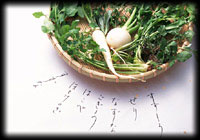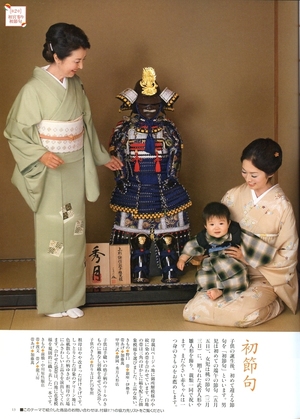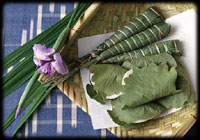The Five Sekku
The word “sekku” in Japanese is based on the word “setsu” which refers to seasonal divisions according to the Chinese calendar used during the Tang Dynasty in which overlapping odd numbers were considered inauspicious when accumulated (yang).
To balance this, events called “Hija” were held and led to customs where people received life energy from plants and conducted rituals to purify evil spirits.
It is said that due to a combination of the Chinese calendar and Japanese farming customs, feasts were held at the imperial palace on certain days to ward off evil spirits and these days became known as “sekku”.
Odd-numbered dates such as March 3rd and May 5th were selected as the five sekku. However, January 1st (New Year’s) is treated as a special case so January 7th was included in the five sekku as “Jinjitsu”.
Although the five sekku system was abolished in 1873, they continued as established annual events.
− January 7th: The Sekku of Jinjitsu The Seven Herbs of Spring
n ancient China, starting on New Year’s Day fortune-telling for livestock was held each day from chicken to dog, pig, sheep, cow, and horse. The seventh day is when fortune-telling for humans began, which is why it became known as “Jinjitsu” or “Human’s Day” and is the origin of the Sekku of Jinjitsu.
It is believed that at that time, the fortunes for the new year were predicted based on the weather of that day and clear skies would herald a good year.

Also, it is said that during the Tang Dynasty, people ate a stew with seven types of vegetables for good luck against illness. When combined with the ancient Japanese custom of wakanatsumi, in which young sprouts growing through the snow are picked at the beginning of the year, this is said to have later evolved into the Japanese tradition of eating nanakusagayu, or “seven herb porridge”.
Centuries later, the government made “Jinjitsu” a public holiday as an official event, and the custom of eating nanakusagayu spread to the general population.
− March 3rd: The Sekku of Jomi Nanohana & Peach Blossoms
n ancient China, there was a purification ritual held in a river during the Sekku of Jomi, followed by a feast. This event was adopted by the Japanese aristocracy during the Heian period and is the origin of the Sekku of Peach in Japan. At that time, people picked medicinal herbs from the mountains on the Sekku of Jomi and used them to purify their bodies and pray for their well-being.

Also, March 3rd was originally a day that involved a rural ritual in which people, regardless of age or gender, made dolls from grass and straw and rubbed them to remove impurities while praying for their health and warding off bad luck.

These customs later merged with the imperial court’s “Hina Play” in which people played with paper dress-up dolls and evolved into “Nagashi Hina”. This is where paper dolls modeled after people are believed to take on their misfortune as they float away on a river.。
Hina Dolls
In the 14th century, this festival was fixed to March 3rd and became a lavish celebration in the imperial court with gorgeously decorated Hina Dolls. This event spread from the imperial court to samurai society and onward to wealthy merchant families and feudal lords. By the 17th century, it had spread to common people as well.
Jomi falls on March 3rd and is also called the Sekku of Peach because it is the time when the peach trees blossom. More recently, it has become commonly known as the Hinamatsuri which celebrates the birth and growth of girls.
− May 5th: The Sekku of Tango Iris, Chimaki, Kashiwamochi
In a custom that came from China, it was said that irises and wormwood were picked and used to decorate homes and gates.
Also, in Japan, the Sekku of Tango had been an event that continued since the 8th century. The word “Tango” originally referred to the first “horse” day of the month in the Chinese zodiac and wasn’t limited to May. But when combined with a Chinese concept that the date and the number of the month matching was special, Tango came to be especially associated with May 5th. At that time, iris and wormwood were considered medicinal herbs that warded off evil, so they were placed in eaves and added to a bath called a “shobuyu”.


May Doll Taisho
As the era moved towards a samurai society, the festival transitioned to one that celebrated military values, with the Japanese word for “iris” a homonym for a word that means “valor”. Sometime around the 18th century, the Tokugawa Shogunate established May 5th as an important ceremonial day, with feudal lords and samurai in ceremonial garb visiting Edo Castle to celebrate and pay homage to the shogun.
In addition, when a son was born to the shogun they would celebrate by erecting large banners, normally used on the battlefield, at their front entrance. Over time, this celebration became popular with common people as a way to celebrate the birth and growth of a son.
※This content was based on Koyomi’s page and Japanese Culture Iroha Encyclopedia.

